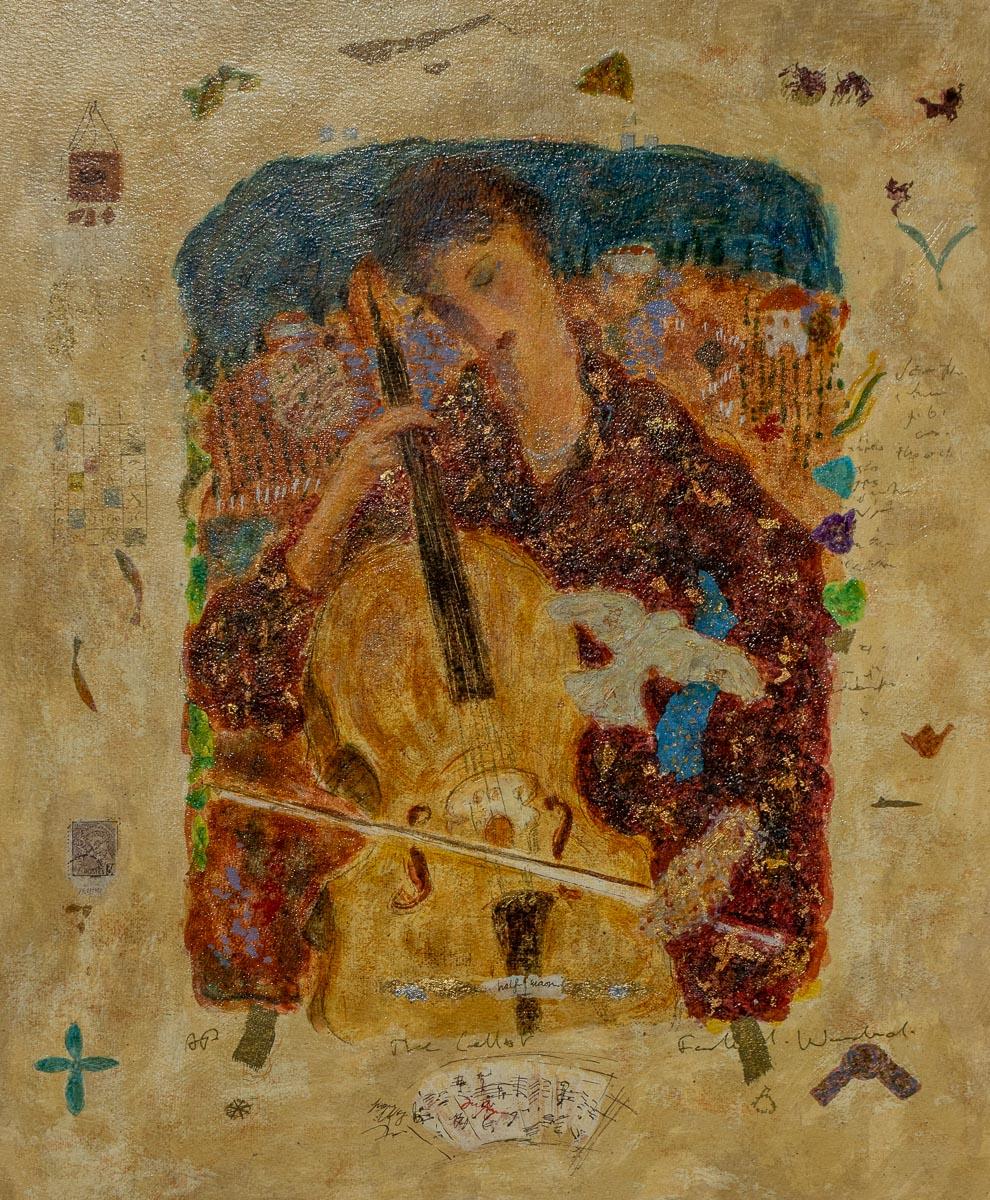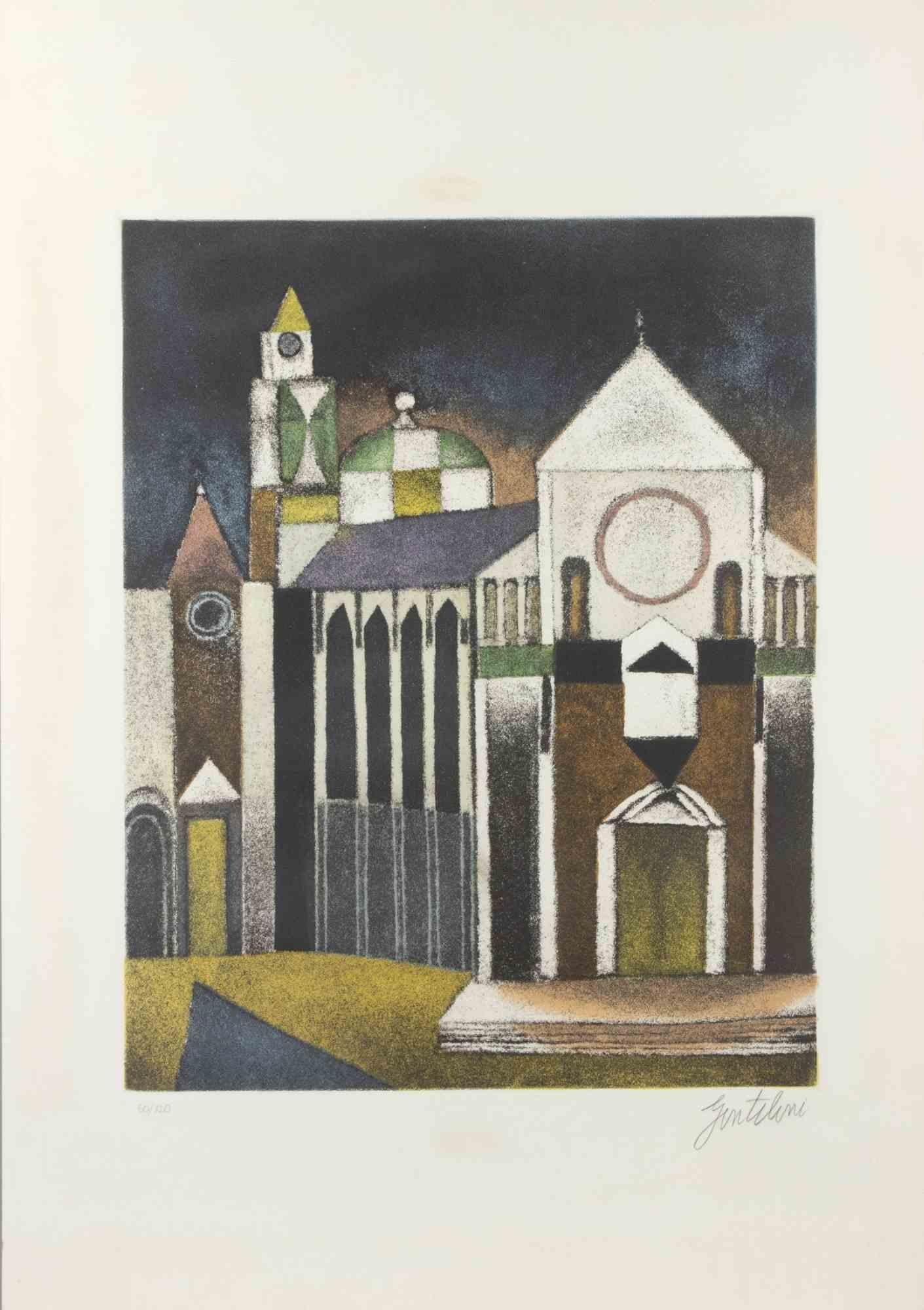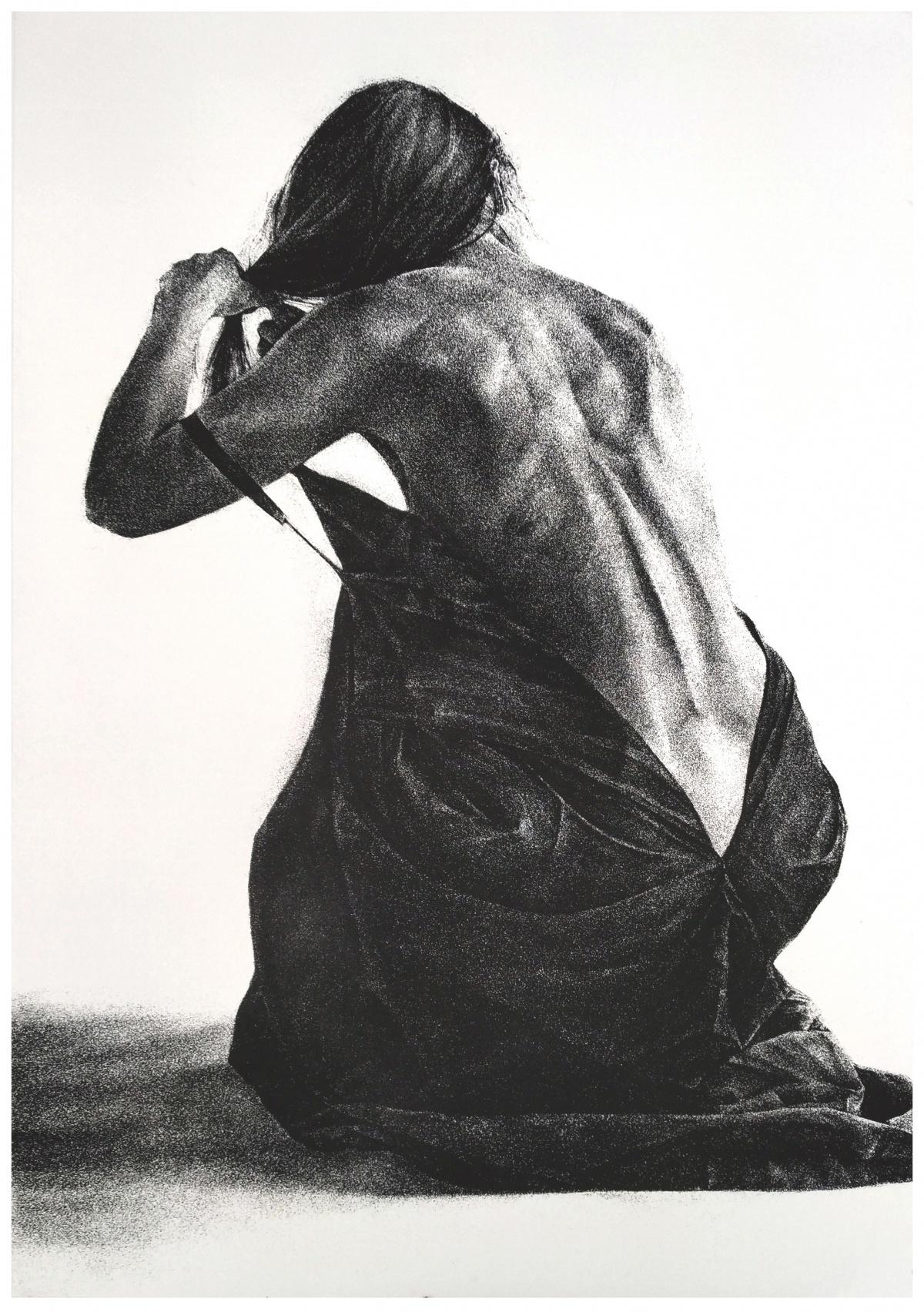Items Similar to Antonio Lopez Saenz Aquatint "Hombres y Sillos" (Men and Chairs)
Want more images or videos?
Request additional images or videos from the seller
1 of 13
Antonio Lopez Saenz 1Antonio Lopez Saenz Aquatint "Hombres y Sillos" (Men and Chairs)1980
1980
About the Item
SALE ONE WEEK ONLY
Antonio Lopez Saenz is a brilliant iconic creative artist from Mazatlan, Mexico. The aquatint “Hombres y Sillos” (Men and Chairs) was created in 1980 and signed, titled and numbered 22/25. This print captures a favorite theme of Antonio's the depiction of a typical scene - men conversing at a table - from his hometown. There is a lighthearted feel to the piece through the peaceful group of men enjoying a cigarette and perhaps discussing the weather. The subdued colors enhance the quiet scene.
Born in 1936, Antonio knew from an early age that he was destined to paint. His work was largely, largely inspired by the 1950s. New York City became the focus for modernism on an international scale during the Post-War period. Many artists had travelled to the city during the Second World War, fleeing in exile from Europe. This led to a substantial pooling of talent and ideas. Influential Europeans such as Piet Mondrian, Josef Albers and Hans Hoffmann provided inspiration for American artists whilst in New York, and influenced cultural growth in the United States for many later decades. Jackson Pollock, Willem de Kooning, Mark Rothko, Frank Kline, Barnett Newman, Clyfford Still and Adolph Gottlieb were predominant artists of this time. The male dominated environment has been subsequently revised to acknowledge the contributions of female artists such as Lee Krasner, Joan Mitchell, and Louise Bourgeois, amongst others. Artists Drudry Brandt, Alina Kalczynska-Scheiwiller, Nik Zainal Abidin, Amalia Del Ponte, and Jean-Pierre Delannoy are of the same generation.
Unframed the piece measures 20.5"h x 24"w
Photography by PD Rearick.
- Creator:Antonio Lopez Saenz 1 (Mexican)
- Creation Year:1980
- Dimensions:Height: 28 in (71.12 cm)Width: 32 in (81.28 cm)
- Medium:
- Movement & Style:
- Period:
- Condition:
- Gallery Location:Detroit, MI
- Reference Number:1stDibs: LU128617912292
About the Seller
5.0
Vetted Seller
These experienced sellers undergo a comprehensive evaluation by our team of in-house experts.
Established in 2014
1stDibs seller since 2019
95 sales on 1stDibs
Typical response time: 4 hours
- ShippingRetrieving quote...Ships From: Detroit, MI
- Return PolicyA return for this item may be initiated within 14 days of delivery.
More From This SellerView All
- Antonio Lopez Saenz Aquatint "Pareja" (Partner)By Antonio Lopez Saenz 1Located in Detroit, MISALE ONE WEEK ONLY Antonio Lopez Saenz is a brilliant iconic creative artist from Mazatlan, Mexico. The aquatint “Pareja” (Partner) was created in...Category
1980s Contemporary Figurative Prints
MaterialsAquatint
- Arnold Singer "Woman on Arm of Sofa" Lithograph Linear Black & WhiteLocated in Detroit, MI“Woman on Arm of Sofa” is an extraordinary lithograph by Arnold Singer. You could say it is representative of his interests in several art styles that ar...Category
1960s Contemporary Figurative Prints
MaterialsLithograph
- Shepard Fairy "We The Future - Rise to Re ....." Silkscreen Signed and DatedBy Shepard FaireyLocated in Detroit, MI"Rise to Rewrite the Law" is a silkscreen offset on speckle tone paper that is the second in Shepard Fairey's crowdfunded WE THE FUTURE series. This work features Amanda Nguyen, the Vietnamese-American founder of the civil rights NGO Rise and drafter of the Sexual Assault Survivors' Rights Act. As part of the WE THE FUTURE campaign her portrait was sent to twenty thousand schools in the United States to teach students about activism. The work is signed and dated in the lower right corner, and is unnumbered open edition work. Shepard Fairey is one of America's most well-known living artists. Born Frank Shepard Fairey in Charleston in 1970, Fairey came into prominence as a street artist and graphic designer whose works such as "Andre the Giant Has a Posse" and the Barack Obama "Hope" poster have become iconic within contemporary culture. He began his art career with doing pieces for skateboards and T-shirts before getting an education at the Rhode Island School of Design where he earned his BA in Illustration. Fairey's work draws on influences as diverse as the films of John Carpenter and the philosophy of Marshall McLuhan and Martin Heidegger...Category
2010s Contemporary Figurative Prints
MaterialsOffset, Screen
- Roy Lichtenstein Tryptich "as I opened fire" 1966 Stedelijk Museum AmsterdBy Roy LichtensteinLocated in Detroit, MISALE ONE WEEK ONLY "As I opened fire" is a lithograph triptych by Roy Lichtenstein whose provenance is printed on verso: Coll. Stedelijk Museum Amsterdam. Editions were copyrighted by the Stedelijk Museum Amsterdam and corrected with the original and printed in the Netherlands. Each piece measures: 25 1/8" h x 20 5/8" w. Roy Fox Lichtenstein was an American pop artist. During the 1960s through the 90’s, along with Andy Warhol, Jasper Johns, and James Rosenquist, he became a leading figure in the new art movement. His work defined the premise of pop art through parody. Most of Lichtenstein's best-known works are relatively close, but not exact, copies of comic book panels, a subject he largely abandoned in 1965. Lichtenstein's Still Life paintings, sculptures and drawings, which span from 1972 through the early 1980s, cover a variety of motifs and themes, including the most traditional such as fruit, flowers, and vases. Inspired by the comic strip, Lichtenstein produced precise compositions that documented while they parodied, often in a tongue-in cheek manner. His work was influenced by popular advertising and the comic book style. His artwork was considered to be "disruptive". He described pop art as "not 'American' painting but actually industrial painting". His paintings were exhibited at the Leo Castelli Gallery in New York City. Wham!, and Drowning Girl Look Mickey proved to be his most influential works. His most expensive piece is Masterpiece which was sold for $165 million in January 2017. Lichtenstein received both his Bachelors and Masters at Ohio State University, Columbus, Ohio where he taught for ten years. In 1967, he moved back to upstate New York and began teaching again. It was at this time that he adopted the Abstract Expressionist style, being a late convert to this style of painting. Lichtenstein began teaching in upstate New York at the State University of New York at Oswego in 1958. About this time, he began to incorporate hidden images of cartoon characters such as Mickey Mouse and Bugs Bunny into is abstract works. In 1960, he started teaching atRutgers University where he was heavily influenced by Allan Kaprow, who was also a teacher at the university. This environment helped reignite his interest in Proto-pop imagery. In 1961, Lichtenstein began his first pop paintings using cartoon images and techniques derived from the appearance of commercial printing. This phase would continue to 1965, and included the use of advertising imagery suggesting consumerism and homemaking. His first work to feature the large-scale use of hard-edged figures and Ben-Day dots was Look Mickey (1961), National Gallery of Art, Washington, D. C.) This piece came from a challenge from one of his sons, who pointed to a Mickey Mouse comic book and said; "I bet you can't paint as good as that, eh, Dad?" In the same year he produced six other works with recognizable characters from gum wrappers and cartoons. It was at this time that Lichtenstein began to find fame not just in America but worldwide. He moved back to New York to be at the center of the art scene in 1964 to concentrate on his painting. Lichtenstein used oil and Magna (early acrylic) paint in his best known works, such as Drowning Girl (1963), which was appropriated from the lead story in DC Comics’ Secret Hearts No. 83, drawn by Tony Abruzzo. (Drowning Girl now hangs in the Museum of Modern Art, New York.) Drowning Girl also features thick outlines, bold colors and Ben-Day dots, as if created by photographic reproduction. Of his own work Lichtenstein would say that the Abstract Expressionists "put things down on the canvas and responded to what they had done, to the color positions and sizes. My style looks completely different, but the nature of putting down lines pretty much is the same; mine just don't come out looking calligraphic, like Pollock’s or Kline’s. Rather than attempt to reproduce his subjects, Lichtenstein's work tackled the way in which the mass media portrays them. He would never take himself too seriously, however, saying: "I think my work is different from comic strips – but I wouldn't call it transformation; I don't think that whatever is meant by it is important to art.” When Lichtenstein's work was first exhibited, many art critics of the time challenged its originality. His work was harshly criticized as vulgar and empty. The title of a Life magazine article in 1964 asked, "Is He the Worst Artist in the U.S.?" Lichtenstein responded to such claims by offering responses such as the following: "The closer my work is to the original, the more threatening and critical the content. However, my work is entirely transformed in that my purpose and perception are entirely different. I think my paintings are critically transformed, but it would be difficult to prove it by any rational line of argument.” In 1969, Lichtenstein was commissioned by Gunter Sachs to create Composition and Leda and the Swan, for the collector's Pop Art bedroom suite at the Palace Hotel in St. Moritz. In the late 1970s and during the 1980s, Lichtenstein received major commissions for works in public places: the sculptures Lamp (1978) in St. Mary's, Georgia; Mermaid (1979) in Miami Beach; the 26 feet tall Brushstrokes in Flight (1984, moved in 1998) at John Glenn Columbus International Airport; the five-storey high Mural with Blue Brushstroke (1984–85) at the Equitable Center, New York and El Cap de Barcelona (1992) in Barcelona. In 1994, Lichtenstein created the 53-foot-long, enamel-on-metal Times Square Mural in Times Square subway station. In 1977, he was commissioned by BMW to paint a Group 5 Racing Version of the BMW 320i for the third installment in the BMW Art Car Project. The DreamWorks Records logo was his last completed project. "I'm not in the business of doing anything like that (a corporate logo) and don't intend to do it again," allows Lichtenstein. "But I know Mo Ostin and David Geffen and it seemed interesting. In 1996 the The National Gallery of Art in Washington, D.C. became the largest single repository of the artist's work when Lichtenstein donated 154 prints and 2 books. The Art Institute of Chicago has several important works by Lichtenstein in its permanent collection, including Brushstroke with Spatter (1966) and Mirror No. 3 (Six Panels) (1971). The personal holdings of Lichtenstein's widow, Dorothy Lichtenstein, and of the Roy Lichtenstein Foundation number in the hundreds. In Europe, the Museum Ludwig in Cologne has one of the most comprehensive Lichtenstein holdings with Takka Takka (1962), Nurse (1964), Compositions I (1964), besides the Frankfurt Museum fur Modern Kunst with We Rose Up slowly (1964), and Yellow and Green Brushstrokes...Category
1960s Pop Art Figurative Prints
MaterialsLithograph
- Axel Crieger Audrey Hepburn Fotocollage Print "Fragility Adored" Ltd EdBy Axel CriegerLocated in Detroit, MISALE ONE WEEK ONLY "Fragility Adored" a Fotocollage print on photographic paper by Axel Crieger (1955 - ) of an Audrey Hepburn publicity photo for "Sabrina" now placed in a cafe. I...Category
1950s Conceptual Figurative Prints
MaterialsPhotographic Paper
- "History of Detroit" Linoleum Cut, Black Ink, African American, Mural StyleBy Hubert MasseyLocated in Detroit, MI"History of Detroit" is in the style of a mural by the master muralist from the city of Detroit, Hubert Massey. It renders in dramatic composition the ov...Category
Early 2000s American Modern Figurative Prints
MaterialsLinocut
You May Also Like
- Montparnasse - Original Etching by Jacques Joachim Jean Rigal - 1970sBy Jacques Joachim Jean RigalLocated in Roma, ITImage dimensions: 34.5 x 44.5 cm. Montparnasse is an original etching by the French artist Jacques Joachim Jean Rigal (1926-1997). This is an original pr...Category
1970s Contemporary Figurative Prints
MaterialsEtching, Aquatint
- Cellest - portrait, hand signed, Roy FairchildBy Roy FairchildLocated in London, GBThis serigraph print is for sale from Roy Fairchild's Personal Collection. This print will come with a certificate of authenticity from London Contemporary Gallery and a unique signe...Category
21st Century and Contemporary Contemporary Mixed Media
MaterialsEtching, Aquatint
- Cathedral - Etching and Aquatint by Franco Gentilini - 1970sBy Franco GentiliniLocated in Roma, ITEtching and Aquatint. Edition 70/120. 65x45 cm. Excellent condition.Category
1970s Contemporary Figurative Prints
MaterialsAquatint, Etching
- Mirror 2 - Contemporary Figurative Print, Black & white, FemaleLocated in Warsaw, PLEdition of 40, signed, numbered AGNIESZKA LECH-BIŃCZYCKA Graduated from University of Rzeszów in a field of Artistic Education with specialisation in g...Category
2010s Contemporary Figurative Prints
MaterialsPaper, Aquatint
- Adynamy - Contemporary Figurative Print, Black & white, FemaleLocated in Warsaw, PLAGNIESZKA LECH-BIŃCZYCKA Graduated from University of Rzeszów in a field of Artistic Education with specialisation in graphics. She obtained her diploma...Category
2010s Contemporary Figurative Prints
MaterialsPaper, Aquatint
- Nude IX - XXI Century, Contemporary Figurative Aquatint Etching PrintBy Marta Wakula-MacLocated in Warsaw, PLMARTA WAKUŁA-MAC: Master of Arts in Fine Art Education- Diploma in Fine Art Printmaking at the Institute of Art, Pedagogical University, Krakow, 2003. Member of Graphic Studio Dubl...Category
2010s Contemporary Nude Prints
MaterialsPaper, Etching, Aquatint




